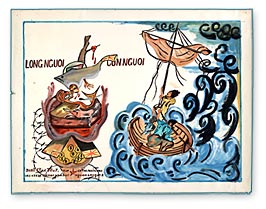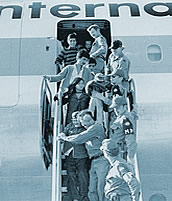 Following the initial wave of emigration from Southeast Asia in 1975, refugees continued to flee their homeland for several reasons: continuing political instability caused by internal power struggles and despotic governmental regimes; the effects of natural disasters; and the threat of political, religious, and ethnic persecution. Following the initial wave of emigration from Southeast Asia in 1975, refugees continued to flee their homeland for several reasons: continuing political instability caused by internal power struggles and despotic governmental regimes; the effects of natural disasters; and the threat of political, religious, and ethnic persecution.
Post-War Unrest in Southeast Asia
When China and Vietnam engaged briefly in a border war in 1978, ethnic Chinese merchants in Vietnam who were targeted for persecution were forced to escape. Some refugees trekked across dangerous terrain into neighboring countries and sought asylum in temporary refugee camps. For example, ethnic Lao, Iu-Mien, Hmong, and Lahu who were being politically persecuted by the new political rulers in Laos crossed the Mekong River and walked through the jungle to border camps in neighboring Thailand. During these escapes, unknown numbers died of starvation or from untreated medical problems, or were killed by enemies. Some returned home when it was safe or relocated in the region, while others were resettled in different parts of the world.
Boat People
Starting in the late 1970s, refugees who became known as “boat people,” such as Vietnamese and ethnic Chinese Vietnamese, also made dangerous escapes in boats on the South China Seas to neighboring countries. Boats sank because of overcrowding or bad weather, people starved without enough food and water, and pirates robbed, raped, kidnapped, or killed refugees. As the camps filled to capacity, overwhelmed nations refused to accept additional refugees. As a result, many perished at sea, including some who were within miles of shore and had their boats pushed back to sea, or who had been ignored by numerous international shipping vessels or cruise ships that could have rescued them. These experiences have left a searing physical and psychological impact on all who survived or witnessed these traumas.
|


 Following the initial wave of emigration from Southeast Asia in 1975, refugees continued to flee their homeland for several reasons: continuing political instability caused by internal power struggles and despotic governmental regimes; the effects of natural disasters; and the threat of political, religious, and ethnic persecution.
Following the initial wave of emigration from Southeast Asia in 1975, refugees continued to flee their homeland for several reasons: continuing political instability caused by internal power struggles and despotic governmental regimes; the effects of natural disasters; and the threat of political, religious, and ethnic persecution.